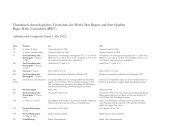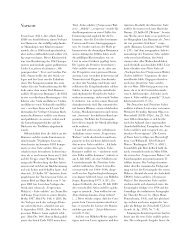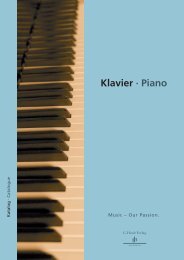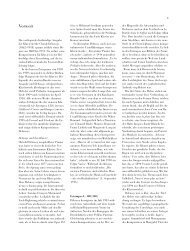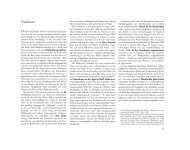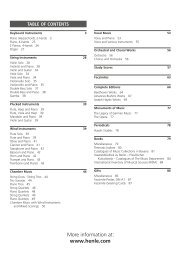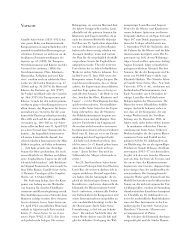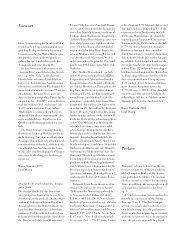Vorwort (PDF, 384 KB) - Henle Verlag
Vorwort (PDF, 384 KB) - Henle Verlag
Vorwort (PDF, 384 KB) - Henle Verlag
You also want an ePaper? Increase the reach of your titles
YUMPU automatically turns print PDFs into web optimized ePapers that Google loves.
ich Ihres Versprechens, daß Sie mir diese<br />
Stücke von Düsseldorf senden würden<br />
und konnte sie kaum vor Ungeduld<br />
erwarten. Und nun diese große unerwartete<br />
Freude! An vielen Orten in<br />
Leipzig so auch kürzlich in Grimma und<br />
Oschatz habe ich diese Stücke mit dem<br />
größten Beifall vorgeführt“ (zitiert nach<br />
Ute Bär, Robert Schumann und Johann<br />
Andreas Grabau, in: Schumann-Forschungen,<br />
Bd. 12, Robert Schumann,<br />
das Violoncello und die Cellisten seiner<br />
Zeit, hrsg. von Bernhard R. Appel<br />
und Matthias Wendt, Mainz etc. 2007,<br />
S. 152, 155).<br />
Ob die erwähnten Aufführungen vor<br />
privatem oder öffentlichem Publikum<br />
stattfanden, bleibt ungewiss. Bislang<br />
wurde immer ein Konzert mit Clara<br />
Schumann und dem berühmten Cellisten<br />
Friedrich Grützmacher am 6. Dezember<br />
1859 im Leipziger Gewandhaus<br />
als erste öffentliche Aufführung angesehen.<br />
Die Violinversion eines der fünf<br />
Stücke hatte Joseph Joachim bereits im<br />
August 1853 bei einem Konzert in Göttingen<br />
öffentlich gespielt.<br />
Genauere Angaben zu Autograph und<br />
Erstausgabe sowie zu den darin enthaltenen<br />
Lesarten finden sich in den Bemerkungen<br />
am Ende dieser Ausgabe. In<br />
den Quellen fehlende, aber musikalisch<br />
notwendige oder durch analoge Stellen<br />
begründete Zeichen sind in runde<br />
Klammern gesetzt.<br />
Allen in den Bemerkungen genannten<br />
Bibliotheken, die freundlicherweise<br />
Fotokopien der Quellen zur Verfügung<br />
gestellt haben, sei herzlich gedankt.<br />
Berlin, Frühjahr 2010<br />
Ernst Herttrich<br />
Preface<br />
The romantic era abounds in works for<br />
the violoncello, whose gentle, sonorous<br />
sound apparently struck a special cord<br />
in the romantic sensibility. Robert Schumann<br />
(1810–56) also contributed important<br />
works to the canon of cello literature,<br />
foremost among them his Cello<br />
Concerto op. 129 of 1850 and the Fünf<br />
Stücke im Volkston (Five Pieces in Folk<br />
Style) op. 102 for piano and cello, written<br />
one year earlier. The composer produced<br />
another work for piano and cello,<br />
Fünf Romanzen or Phantasiestücke, in<br />
early November 1853; but it remained<br />
unpublished, even though the pieces<br />
had met with great acclaim during various<br />
trial performances. As late as March<br />
1855, Schumann wrote to Brahms from<br />
Endenich that he intended to have them<br />
published by Breitkopf & Härtel. Later,<br />
Clara Schumann came to regard the<br />
pieces, with Brahms’s acquiescence, as<br />
unworthy of publication and destroyed<br />
them along with other manuscripts in<br />
1893, since she was afraid that they<br />
might still have been released after her<br />
death. It should be noted that all three<br />
works were written in Schumann’s later<br />
years, which is all the more remarkable<br />
as the cello was the very instrument<br />
which, along with the piano, he had<br />
learned to play in his youth. But he had<br />
already assigned a privileged role to the<br />
cello in some of his earlier orchestral<br />
works as well, such as the slow movements<br />
of the 1 st and 4 th Symphonies, the<br />
Piano Concerto or the Faustszenen.<br />
Schumann basically only began writing<br />
instrumental duets in early 1849. As<br />
was so often the case, he then produced<br />
in a close succession several works for<br />
piano and one accompanying instrument<br />
in a variety of scorings: in February<br />
the Adagio und Allegro op. 70 for<br />
horn and the Fantasiestücke op. 73 for<br />
clarinet, in April the Fünf Stücke im<br />
Volkston op. 102 for cello and in December<br />
the Romanzen op. 94 for oboe.<br />
This creative surge was followed in<br />
1851 by the two Violin Sonatas op. 105<br />
V<br />
and 121 and the Märchenbilder op. 113<br />
for piano and viola.<br />
Details concerning the origin of the<br />
Fünf Stücke im Volkston op. 102 can<br />
again be found in the Haushaltbuch. On<br />
15 April 1849 Schumann recorded the<br />
completion of “4 pieces for cello.” Two<br />
days later, we read: “5 th piece for violoncello.”<br />
He seems to have played them to<br />
Clara a few days later, for she joyfully<br />
noted in her diary on 19 April: “These<br />
are the pieces in folk style, which absolutely<br />
beguiled me with their freshness<br />
and originality” (Berthold Litzmann,<br />
Clara Schumann. Ein Künstlerleben.<br />
Nach Tagebüchern und Briefen, vol. II,<br />
Ehejahre 1840–1856, Leipzig, 7 1925,<br />
p. 185). A short while later, the work<br />
was given its first tryout with cello.<br />
After the brothers Franz and Friedrich<br />
Schubert (violinist and cellist in the<br />
Royal Chapel in Dresden) had paid him<br />
a visit on 24 April 1849, Schumann<br />
wrote in the Haushaltbuch: “This afternoon<br />
with the Schuberts – Trio in F major<br />
I a [prima, i. e. for the first time], cello<br />
pieces as well.”<br />
The following year, the Schumanns<br />
spent the months of May to July in Leipzig<br />
for the preparation of the premiere<br />
of Genoveva. On 8 June, a party celebrating<br />
Schumann’s 40 th birthday was<br />
held there in the home of the Preußer<br />
family (Schumann dedicated his Waldszenen<br />
op. 82 to the Preußer daughter<br />
Annette). In his Haushaltbuch, the<br />
composer wrote: “My 40 th birthday.<br />
Great joy. – In the morning a serenade<br />
by the Pauliner Verein and the orchestra.<br />
– Then gifts, with Marie and Lieschen<br />
behind flowers. […] Musical surprises<br />
in the evening: the Minnespiel,<br />
the pieces for cello. – Gade. – Joachim. –<br />
Also annoyance and bad temper.” The<br />
closing words referred to the very cool<br />
reception given to the two new works by<br />
the guests.<br />
Nevertheless, the work received a<br />
very positive review in the Neue Zeitschrift<br />
für Musik when it was published<br />
the following year. The critic Emmanuel<br />
Klitzsch began by interpreting the designation<br />
“in folk style” and continued:<br />
“They are certainly not intended for unreflecting<br />
players […]. The humour, the



